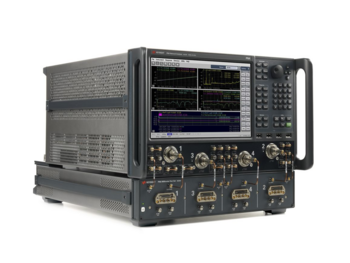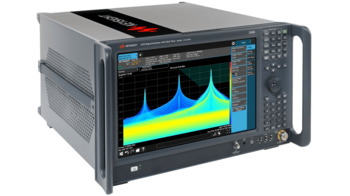This article is brought to you by the Keysight Used Equipment Store. The information applies to used and new equipment.
If you know which Keysight model is of interest to you and matches your technical requirements, visit the Used Equipment Store to see if you can save with our offers.
View Our Offers
For more Test and Measurement knowledge and tips, view all technical articles. Visit our resources
Keysight assumes no liability for the completeness, correctness and accuracy of all content on this website and all of its content. Please read here the terms of use of this website.
Article Feedback
Give us any feedback you might have about this article.
- Introduction
- What Is a Network?
- What Is Network Analysis?
- Network Approaches and Tools
- Sparse Networks and Time-Series Networks
- Node Centrality and Centrality Measures
- Environmental Factors and Causal Effects
- Model Selection and Spurious Edges
- What Is a Network Analyzer Used For?
- Network Analyzer vs. Spectrum Analyzer: What Is the Difference?
- What Does a Vector Network Analyzer Do?
- What Is Time Domain Analysis?
- Network Analysis Summary
- Keysight Oscilloscopes
Imagine the frustration and confusion of navigating an endless maze of intertwined wires and connections. As an engineer, the challenge of understanding and optimizing intricate networks can feel just as overwhelming.
But what if there was a solution to the complexities of network analysis tailored just for engineers? Welcome to the network analysis and network science world, where advanced tools and techniques, such as network analysis tools, transform confusion into clarity.
In this article, we'll dive into the world of networks, looking at their structure and revealing the secrets behind their efficient operations.
By exploring the advanced methods and equipment used in network analysis, such as types of network analysis and network maps, we aim to empower you as engineers with the knowledge and tools required to conquer even the most daunting network challenges.
| Key Takeaway |
|---|
| Network analysis is a method for understanding and optimizing networks' structure, behavior, and performance. It helps professionals identify patterns, troubleshoot issues, and enhance the efficiency of network systems. |
Buy Oscilloscopes at a Great Discount
- Like-new Condition
- Updated Firmware
- Full Calibration
- New Accessories
- Like-new Warranty
- Customization possible
- Savings of up to 90%
- Working Condition
- Calibrated or Tested
- 30-Day Right-of-Return
- No Customization
- Shipping to limited countries
What Is a Network?
A network is a system of interconnected nodes or points that exchange information, data, or energy. These networks are everywhere – from the internet and telecommunications to social connections and transportation systems.
In engineering, networks can be electrical circuits, communication systems, or computer networks. Here are some key terms to help you understand networks better.
- Central node. A node that holds a significant position in the network due to its connections with other nodes.
- Network topology. The arrangement of nodes and links in a network.
- Network service. A function or feature that a network provides.
What Is Network Analysis?
Network analysis examines, measures, and models networks to better understand their structure, behavior, and performance. It helps you and fellow engineers and researchers in various fields to
- Identify patterns of relationships
- Uncover anomalies
- Optimize network performance
- Identify and fix potential problems
Some of the fundamental analysis techniques used in network analysis include
- Degree centrality. A measure of a node's importance based on its connections within the network.
- Graph theory. A mathematical method to represent networks and analyze their structural properties.
- Random graph models. A type of statistical model that generates graphs with specified properties.
Network Approaches and Tools
There are various types of network analysis tools and approaches to help engineers work with complex networks. Network analyzers are important instruments designed to analyze and test various aspects of a network, while partial correlation network analysis helps understand causal relationships between network variables.
The type of network analysis you use depends on your system's complexity and objectives.
Sparse Networks and Time-Series Networks
Sparse networks have relatively few connections between nodes, while time-series networks represent the connections between nodes over time. Analyzing these networks helps to identify dynamical processes and temporal effects that may impact a network's performance.
Sparse networks are generally easier to analyze than time-series networks due to their lower complexity. Still, both require advanced techniques and powerful tools, such as network simulations, for effective analysis.
Performing a network analysis allows you to identify bottlenecks, optimize system performance, and detect anomalies in the data.
Node Centrality and Centrality Measures
Node centrality is a crucial aspect of network analysis that deals with the importance of nodes within the network. Centrality measures, such as degree centrality, can help determine which nodes are critical to the network's overall functioning.
Analyzing node centrality can provide valuable insights into the different roles played by individual nodes within a network and help you identify patterns and anomalies in the data.
Environmental Factors and Causal Effects
Network analysis also involves accounting for environmental factors that may impact network performance. Understanding causal effects can aid in optimizing network efficiency and addressing potential issues, such as identifying which nodes are most likely to cause faults or failures.
Model Selection and Spurious Edges
Selecting appropriate statistical and graphical models is vital to analyze complex networks effectively. Detecting spurious edges, connections that may not reflect true relationships between nodes, is essential to avoid errors.
What Is a Network Analyzer Used For?
A network analyzer is an essential tool for engineers working with complex networks. It's a versatile instrument designed to analyze and test various aspects of a network, including
- Frequency range. Network analyzers can cover a wide range of frequencies, from low-frequency audio to high-frequency radio signals.
- Signal parameters. Network analyzers can be set up to test various parameters, such as return loss, impedance, and signal transmission.
- Capture times. They can capture and analyze network data over time, allowing you to study network performance and identify potential issues.

Network Analyzer vs. Spectrum Analyzer: What Is the Difference?
While both network and spectrum analyzers are essential tools for engineers, they serve different purposes.
- Network analyzers primarily focus on analyzing the characteristics and performance of a network, such as transmission, reflection, and impedance.
- Spectrum analyzers, on the other hand, measure the amplitude and frequency of signals within a specified frequency range.
In their simplest forms, network analyzers deal with the relationships between components in a network, while spectrum analyzers focus on the properties of individual signals.

What Does a Vector Network Analyzer Do?
A vector network analyzer (VNA) is a powerful network analyzer that measures both the magnitude and phase of network parameters. The ability to measure both parameters gives you more insight into the network's performance and behavior.
Some key features of VNAs include
- Dynamic range. VNAs measure a wide range of weak to strong signal levels.
- Channel frequency response. VNAs accurately measure the response of a network across different frequencies.
- Channel Power Indicator. A feature that allows you to monitor the power levels of various channels in a network.
What Is Time Domain Analysis?
Time domain analysis is a technique used to analyze network data in the time domain, meaning it focuses on how network parameters change over time. This approach is beneficial for analyzing transient or time-varying phenomena in networks, such as signal propagation and reflection.
Time domain analysis offers several advantages for engineers, including
- Segmented captures. By dividing the time domain data into segments, you can focus on specific events or periods of interest, making it easier to identify and analyze network behavior.
- Common time axis. Time domain analysis allows you to compare different network parameters and events on a common time scale, facilitating a better understanding of the interactions between various network components.
- Improved troubleshooting. Time domain analysis lets you pinpoint the exact timing of issues or anomalies, making diagnosing and resolving network problems easier.
Network Analysis Summary
Network analysis is a fascinating field that helps engineers and researchers make sense of complex network structures and interactions.
Using network analyzers, vector network analyzers, and time domain analysis techniques, you can gain valuable insights into network performance, troubleshoot potential issues, and optimize network efficiency.
With the growing importance of network analysis in various aspects of our lives, engineers and researchers increasingly rely on innovative techniques and tools, such as network maps and different types of network analysis, to tackle complex relationships, causal effects, and other challenges.
As networks play a massive role in industries like telecommunications and computer science, the importance of network analysis is only set to grow.
By mastering these techniques and understanding how to use network analysis tools effectively, you can better navigate and understand how networks operate and how to improve their performance.
Browse Oscilloscopes at a Great Discount
- Like-new Condition
- Updated Firmware
- Full Calibration
- New Accessories
- Like-new Warranty
- Customization possible
- Savings of up to 90%
- Working Condition
- Calibrated or Tested
- 30-Day Right-of-Return
- No Customization
- Shipping to limited countries
Keysight Oscilloscopes
When it comes to tech equipment, you want the best of the best. That's why Keysight oscilloscopes and network analyzers are perfect for your needs. With industry-leading performance, they're the ideal tools for many applications.
From basic signal analysis to complex measurements and network analysis tasks, Keysight digital oscilloscopes and network analyzers have you covered.
With models ranging from entry-level to high-end, there's a Keysight device that's perfect for your needs. So why settle for anything less?
See Keysight's Used Equipment to find a wide variety of oscilloscopes and network analyzers to fit your needs and budget.

This article is brought to you by the Keysight Used Equipment Store. The information applies to used and new equipment.
If you know which Keysight model is of interest to you and matches your technical requirements, visit the Used Equipment Store to see if you can save with our offers.
View Our Offers
For more Test and Measurement knowledge and tips, view all technical articles. Visit our resources
Keysight assumes no liability for the completeness, correctness and accuracy of all content on this website and all of its content. Please read here the terms of use of this website.

































































































